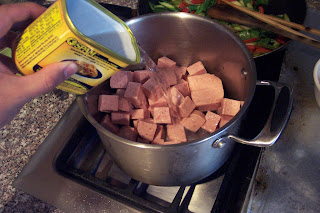Hey Cast Iron Therafans, today we pay tribute to one of the most versatile of proteins, the egg. Boiled, an ingredient in baked goods, fried in all manner of ways, the egg is very broad in its ability to satisfy cravings. In this post, the treatment is a distinctly Vietnamese manner, steaming. This isn't necessarily the traditional way, as I doubt that in olden times Vietnamese farmers had Corelle dessert-cups, but hey use what you've got!
Cha Trung Hap is basically a Vietnamese meatloaf, with a slightly higher emphasis on eggs, cooked through a steaming method, rather than an oven. There's a fried variant as well, but let's pretend this is a healthier version.
The recipe is at the end, but first the picture breakdown.
This is the true base of the dish, a mixture of ground pork, garlic and onion is marinated with a healthy dosing of fish sauce. Yes, fish sauce is in everything in Vietnamese cooking. I suppose you could use salt if you're a coward.
Rice vermicelli is soaked in hot water until it is soft.
And chopped up into little pieces about so. I guess roughly 3/4 of an inch but it's hardly an exact science.

Mix into the pork.
Start cracking some eggs and beating them roughly. We don't want them blended too well here.
The pork is incorporated into the egg gently. I found that using two forks and smashing the pork between the tines to break it apart.
Set the corelle or other durable bowl into a larger pot and set into some water, and bring to a rolling boil, then lower heat to a gentle boil. This will cook for at least 20 minutes.
Here it is not quite done yet. You want the eggs to be fully cooked and set. A stab with a chopstick will not result in yolk coming out.
And here it is. Scoop out onto rice and enjoy.
The rough and ready recipe:
1/2 pound ground pork.
1/4 cup chopped onion
2 cloves garlic, smashed.
4 tablespoons and
4 tsp. fish sauce.
4-5 eggs
1 bundle of rice vermicelli (Not a whole package, they come in threes or sometime fours)
1. Mix ground pork, onion, and garlic, mix with 4 tablespoons of fish sauce let marinate for at least an hour or overnight in the refrigerator.
2. Soak rice vermicelli in hot water. Check every 5 minutes for a soft consistency, then remove to drain.
3. Chop vermicelli into small pieces. Mix with the ground pork mixture.
4. Crack 4 eggs, beat lightly.
5. Incorporate mixture into eggs, and add 4 tsp of fish sauce.
6. If it looks like the eggs are just mixed into the pork covering it all, perfect. If you need an extra egg, go for it.
7. Put in a bowl that will fit in a larger pot and set in a few inches of water, safely under the bowl's edge. Put a plate or a lid on the bowl.
8. Bring to rolling boil, then a gentle boil. Check after 20 minutes. The dish is done when a stab no longer results in liquid egg coming from it.






























